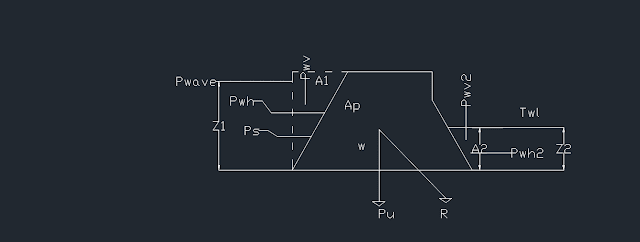Dams
Dams are structures built to
divert or store water for irrigation, water supply, flood control, electric
power generation and/or navigational purposes. Dams are classified on the basis
of the types and materials of construction. The major types are gravity, arch,
buttress and earth dams. The first three types are usually constructed out of
concrete. A gravity dam depends on its own weight for stability and is usually
straight on plan even though it may sometimes be slightly curved. Arch dams
transmit most of the horizontal thrust of the water behind to the abutments by
arch action and have thinner cross-section when compared with gravity dam. Arch
dams are preferably used in narrow canyons where the walls are capable of
withstanding the thrust produced by the arch action. The simplest type of the
buttress dams is the slab type which consists of sloping flat slabs supported
at intervals. Earth dams are embankments of rock or earth with provision for
controlling seepage by means of an impermeable core or upstream blanket.
divert or store water for irrigation, water supply, flood control, electric
power generation and/or navigational purposes. Dams are classified on the basis
of the types and materials of construction. The major types are gravity, arch,
buttress and earth dams. The first three types are usually constructed out of
concrete. A gravity dam depends on its own weight for stability and is usually
straight on plan even though it may sometimes be slightly curved. Arch dams
transmit most of the horizontal thrust of the water behind to the abutments by
arch action and have thinner cross-section when compared with gravity dam. Arch
dams are preferably used in narrow canyons where the walls are capable of
withstanding the thrust produced by the arch action. The simplest type of the
buttress dams is the slab type which consists of sloping flat slabs supported
at intervals. Earth dams are embankments of rock or earth with provision for
controlling seepage by means of an impermeable core or upstream blanket.
Erection of Dams
Erection of dams usually
require the consideration of certain factors since their usefulness when
appropriately designed and sited have enormous benefits. On the contrary, their
failure can result in considerable socio-economic and environmental losses.
These factors are:
require the consideration of certain factors since their usefulness when
appropriately designed and sited have enormous benefits. On the contrary, their
failure can result in considerable socio-economic and environmental losses.
These factors are:
1. Geographical, because
of the resulting modification of the surrounding landscape.
of the resulting modification of the surrounding landscape.
2. Geological, in
respect to the appropriateness of the bedrock strata which will reduce seepage
losses.
respect to the appropriateness of the bedrock strata which will reduce seepage
losses.
3. Economic in
respect to alternative water resource development options.
respect to alternative water resource development options.
4. Social, such
as problems of health and resettlement.
as problems of health and resettlement.
5. Environmental implication.
Forces on Dams
A
dam must be relatively impervious to water and capable of resisting gravity
i.e., its own weight, hydrostatic pressure (sediment deposits and flowing
water), uplift, earthquake forces, etc. The forces are transmitted to the
foundation and abutment of the dam which react against the dam with equal and
opposite force.
dam must be relatively impervious to water and capable of resisting gravity
i.e., its own weight, hydrostatic pressure (sediment deposits and flowing
water), uplift, earthquake forces, etc. The forces are transmitted to the
foundation and abutment of the dam which react against the dam with equal and
opposite force.
General approach for design
of gravity dams
of gravity dams
For small
dams and preliminary design of large dams, it is adequate to use the simplified
approach based on the elastic behavior of concrete. Final design of large dams
however, may require the use of sophisticated methods involving finite
element methods.
dams and preliminary design of large dams, it is adequate to use the simplified
approach based on the elastic behavior of concrete. Final design of large dams
however, may require the use of sophisticated methods involving finite
element methods.
Procedure for designing
gravity dams
gravity dams
1. Assume
the dimensions of the dam.
the dimensions of the dam.
2. Check
the static and dynamic stability.
the static and dynamic stability.
In
order to avoid tensile stresses, the resultant force R, must be kept within the
middle third of the base. In the simplified approach, the dam is divided into
slices and each slice is assumed to act independent of adjoining slices.
order to avoid tensile stresses, the resultant force R, must be kept within the
middle third of the base. In the simplified approach, the dam is divided into
slices and each slice is assumed to act independent of adjoining slices.
Fig.
1: A diagrammatic representation of a dam
1: A diagrammatic representation of a dam
Loads on dam
There are two main load categories on a dam. They are
main loads and secondary loads.
main loads and secondary loads.
1) Main
Loads: The main loads consist of water load, self-weight,
seepage and uplift load.
Loads: The main loads consist of water load, self-weight,
seepage and uplift load.
a) Hydrostatic pressure: Pw = YZ1
Force
= Pwh = 1/2YZ12
= Pwh = 1/2YZ12
This
acts at 1/3Z above datum.
acts at 1/3Z above datum.
b) The vertical force Pwv is accounted for if the upstream face
has a batter or flare as in the diagram above.
has a batter or flare as in the diagram above.
Pwv
= Y (Area, A1), and acts through the centroid of A1
= Y (Area, A1), and acts through the centroid of A1
c) Tail water Pwh2 = 1/2YZ22
d) Vertical force Pwv2 = Y (Area, A2); Y =
unit weight of water = 10kN/m^3
unit weight of water = 10kN/m^3
2) Self
weight:
weight:
For self weight, W = YcAp kN/m^3
For
heavy special concrete, Yc = 31.5 kN/m^3
heavy special concrete, Yc = 31.5 kN/m^3
Where
Yc is the unit weight of concrete, and Yc is = 23.5 (approximately 24) kN/m^3
for normal concrete.
Yc is the unit weight of concrete, and Yc is = 23.5 (approximately 24) kN/m^3
for normal concrete.
3) Seepage
and uplift load: Interstitial
water pressure, Uw develops within a concrete dam and its foundation as a
result of preferential water penetration along discontinuities, e.g. cracks and
fine fissures.
and uplift load: Interstitial
water pressure, Uw develops within a concrete dam and its foundation as a
result of preferential water penetration along discontinuities, e.g. cracks and
fine fissures.
Uplift
load Pu = nAn(Uwavg)
load Pu = nAn(Uwavg)
Originally posted on June 4, 2019 @ 11:42 pm

